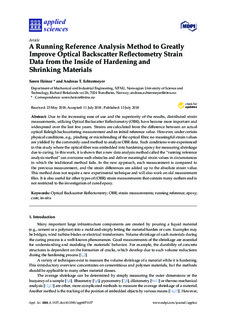| dc.contributor.author | Heinze, Søren | |
| dc.contributor.author | Echtermeyer, Andreas | |
| dc.date.accessioned | 2018-08-10T08:33:53Z | |
| dc.date.available | 2018-08-10T08:33:53Z | |
| dc.date.created | 2018-07-18T12:19:22Z | |
| dc.date.issued | 2018 | |
| dc.identifier.citation | Applied Sciences. 2018, 8 1137-?. | nb_NO |
| dc.identifier.issn | 2076-3417 | |
| dc.identifier.uri | http://hdl.handle.net/11250/2525381 | |
| dc.description.abstract | Due to the increasing ease of use and the superiority of the results, distributed strain measurements, utilizing Optical Backscatter Reflectometry (OBR), have become more important and widespread over the last few years. Strains are calculated from the difference between an actual optical Raleigh backscattering measurement and an initial reference value. However, under certain physical conditions, e.g., pinching or microbending of the optical fiber, no meaningful strain values are yielded by the commonly-used method to analyze OBR data. Such conditions were experienced in this study where the optical fiber was embedded into hardening epoxy for measuring shrinkage due to curing. In this work, it is shown that a new data analysis method called the “running reference analysis method” can overcome such obstacles and deliver meaningful strain values in circumstances in which the traditional method fails. In the new approach, each measurement is compared to the previous measurement, and the strain differences are added up to the absolute strain value. This method does not require a new experimental technique and will also work on old measurement files. It is also useful for other types of (OBR) strain measurements that contain many outliers and is not restricted to the investigation of cured epoxy. | nb_NO |
| dc.language.iso | eng | nb_NO |
| dc.publisher | MDPI | nb_NO |
| dc.rights | Navngivelse 4.0 Internasjonal | * |
| dc.rights.uri | http://creativecommons.org/licenses/by/4.0/deed.no | * |
| dc.title | A Running Reference Analysis Method to Greatly Improve Optical Backscatter Reflectometry Strain Data from the Inside of Hardening and Shrinking Materials | nb_NO |
| dc.type | Journal article | nb_NO |
| dc.type | Peer reviewed | nb_NO |
| dc.description.version | publishedVersion | nb_NO |
| dc.source.pagenumber | 1137-? | nb_NO |
| dc.source.volume | 8 | nb_NO |
| dc.source.journal | Applied Sciences | nb_NO |
| dc.identifier.doi | 10.3390/app8071137 | |
| dc.identifier.cristin | 1597769 | |
| dc.description.localcode | (C) 2018 by the authors. Licensee MDPI, Basel, Switzerland. This article is an open access article distributed under the terms and conditions of the Creative Commons Attribution (CC BY) license (http://creativecommons.org/licenses/by/4.0/). | nb_NO |
| cristin.unitcode | 194,64,92,0 | |
| cristin.unitname | Institutt for maskinteknikk og produksjon | |
| cristin.ispublished | true | |
| cristin.fulltext | postprint | |
| cristin.qualitycode | 1 | |

